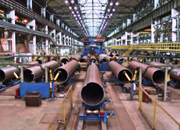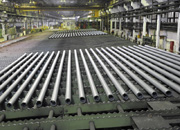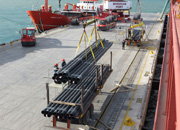EN10219, as the core standard for cold-formed welded hollow profiles for structural use in Europe, sets stringent requirements for the process performance testing of S235 straight seam welded steel pipes. From flattening tests to bending tests, from flaring tests to hydraulic tests, each testing step revolves around "safe load-bearing capacity" and "stable operation," ensuring the reliable performance of welded steel pipes in construction, bridges, and machinery manufacturing.
According to EN10219, S235 straight seam welded steel pipes with an outer diameter greater than 60.3 mm require a flattening test. In the test, the sample is placed between two parallel pressure plates and gradually compressed to a specific distance (e.g., welded steel pipes with a yield strength ≥345 MPa need to be compressed to 3/4 of their outer diameter). During this process, the weld seam must be positioned at 90° and 0° to the direction of force application to comprehensively test the crack resistance of the weld seam and the base material.
In a certain engineering case, a batch of S235 straight seam welded steel pipes performed excellently in the flattening test: when the pressure plate was compressed to 2/3 of the outer diameter, no cracks or delamination appeared in the sample; when further compressed to 1/3 of the outer diameter, only slight deformation occurred in the base material on both sides of the weld, but it did not affect the overall structural integrity. This result proves that this batch of welded steel pipes meets the ductility test requirements of EN10219 and can withstand deformation under extreme working conditions without failure.
For S235 straight seam welded steel pipes with an outer diameter ≤ 60.3 mm, the bending test is an effective alternative to the flattening test. In the test, the welded steel pipe needs to be bent at a radius of 6 times the outer diameter, completing a 90° cold bend, with the weld located on the outer side in the bending direction. This design simulates actual bending scenarios in pipe installation, such as local deformation when passing through walls or equipment.
In a bridge construction project, S235 straight seam welded steel pipes were used as the supporting structure. In the bending test, a 50mm diameter welded steel pipe, after being bent at a radius of 300mm, exhibited a continuous weld without breakage, and only slight wrinkles appeared on the base material surface, without affecting the sealing performance of the fluid transport within the pipe. This performance verifies the adaptability of the welded steel pipe in complex installation environments, providing double protection for project safety.
According to customer requirements, S235 straight seam welded steel pipes can also undergo flaring tests. In this test, a flaring tool with a mandrel taper of 30°, 45°, or 60° enlarges the outer diameter of the welded steel pipe end by 6% to test the ductility of the end material and the crack resistance of the weld.
The process performance inspection of EN10219 S235 straight seam welded steel pipes is a comprehensive quality control effort, encompassing materials, structure, and both local and overall aspects. Through ductility verification via flattening tests, flexibility assessment via bending tests, end strength testing via flaring tests, sealing performance evaluation via hydraulic tests, and internal defect screening via non-destructive testing, each welded steel pipe must undergo five rigorous tests before reaching the market. This rigorous testing system is not only a faithful adherence to European standards, but also a solemn commitment to engineering safety and the protection of life and property.
 Threeway Steel is known as a professional supplier engaged in manufacturing and distributing a wide range of steel pipe, and our headquarter located the central part of China – Hunan and six associated factories throughout China.
Threeway Steel is known as a professional supplier engaged in manufacturing and distributing a wide range of steel pipe, and our headquarter located the central part of China – Hunan and six associated factories throughout China.
 Threeway Steel is known as a professional supplier engaged in designing, manufacturing and distribution of a wide range of steel products with the headquarter located the central part of China – Hunan and six associated factories throughout China.
Threeway Steel is known as a professional supplier engaged in designing, manufacturing and distribution of a wide range of steel products with the headquarter located the central part of China – Hunan and six associated factories throughout China.
 Threeway Steel is known as a professional supplier engaged in designing, manufacturing and distribution of a wide range of steel products with the headquarter located the central part of China – Hunan and six associated factories throughout China.
Threeway Steel is known as a professional supplier engaged in designing, manufacturing and distribution of a wide range of steel products with the headquarter located the central part of China – Hunan and six associated factories throughout China.
 Threeway Steel is known as a professional supplier engaged in designing, manufacturing and distribution of a wide range of steel products with the headquarter located the central part of China – Hunan and six associated factories throughout China.
Threeway Steel is known as a professional supplier engaged in designing, manufacturing and distribution of a wide range of steel products with the headquarter located the central part of China – Hunan and six associated factories throughout China.
 Threeway Steel is known as a professional supplier engaged in designing, manufacturing and distribution of a wide range of steel products with the headquarter located the central part of China – Hunan and six associated factories throughout China.
Threeway Steel is known as a professional supplier engaged in designing, manufacturing and distribution of a wide range of steel products with the headquarter located the central part of China – Hunan and six associated factories throughout China.

